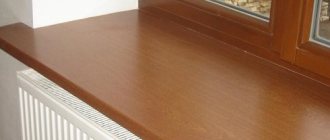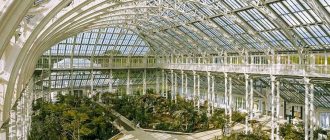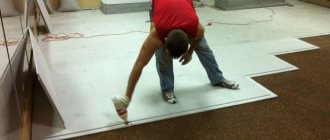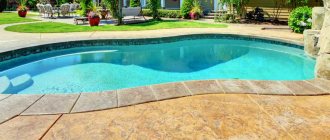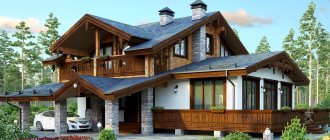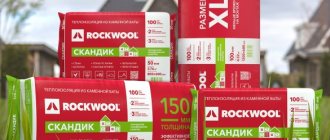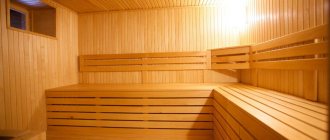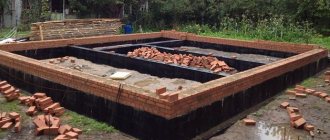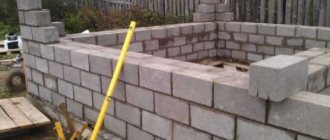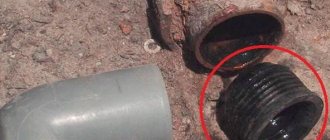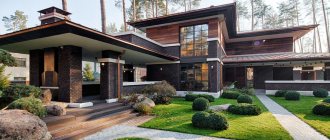Recently, the technology of arranging vegetable roofs has become very popular. A green roof is a multi-level roofing “pie” on which you can grow unpretentious beautiful lawns or even set up a real garden. Today, green roofs are installed with your own hands not only on the roof of a private house in rural areas, but also on urban high-rise buildings.
The main advantages of a green roof
It should be noted that greening the roof provides the opportunity for significant savings during the heating season. Often this is enough to maintain the temperature, because the layer of soil and the roofing pie perfectly retain heat in the interior. In addition, grass on the roof of a house can give any building an aesthetically beautiful appearance ; it serves as a source of oxygen. According to research, 150 sq.m. the green roof is enough to provide the necessary oxygen for 100 people for a year.
Engineering and economic advantages of a green roof
- A significant increase in the service life of the structure: that is, plants on the roof are a natural protection against temperature fluctuations, mechanical damage, and exposure to ultraviolet radiation;
- Passive heat saving is guaranteed due to the excellent thermal insulation properties of the green roof. That is, energy is saved during winter periods, and in the hot season the roof does not overheat;
- Water saving – carried out due to the absorption of rainwater;
- Excellent sound insulation: plants on the roof reduce the degree of reflection of sound waves from the roof surface and significantly increases the level of sound insulation;
- There is no need to create special operating conditions, as well as additional investments;
- Additional seating area;
- The possibility of rapid spread of fire during a fire along the roof surface is eliminated;
- Possibility of placing various types of communications both during installation and after;
- Ease of installation work;
- Prevents soil sliding;
- Local accessibility to waterproofing;
- An anti-measles air layer is created to protect the waterproofing from the roots.
Key benefits from an environmental point of view
- Additional source of oxygen;
- Neutralizes dust and harmful gases in the environment through their absorption;
- Creates a natural green area;
- Regulates air humidity;
- The possibility of obtaining new spaces for the life of flora and fauna:
- Completely universal, it can be installed in any corner of the planet where vegetative soil cover exists.
Image and social benefits
- Guarantees a high rating during certification for compliance with green standards;
- Gives the roof and the entire building a beautiful appearance.
Why is this method of decoration so good?
Roofs covered with greenery and entwined with flowers are very beautiful. But, as it turned out, beauty is not the only advantage of such an unusual garden.
You should not miss the slightest opportunity to decorate your life with flowers. With vegetation on the roof, this structure looks like a fairy-tale gingerbread house
Let us list the main advantages that this landscaping gives us.
- Thermal insulation is improved. The additional coating can be perceived as an excellent thermal insulator. The owner of such a unique clearing can save on heating or air conditioning. If we are talking about unheated structures, which include chicken coops, doghouses, garages and some workshops, then the most favorable microclimate for the inhabitants is formed in them.
- The quality composition of the air changes. Increasing the number of living plants on the site has a beneficial effect on the general condition of the air, because more oxygen is produced as a result of photosynthesis.
- Air dust levels are reduced. Green spaces hold a large amount of dust.
- Absorption of excess moisture during the rainy season. The soil reduces the rate of storm water runoff from the roof surface.
- The soil, like a natural filter, purifies rainwater. As a result, neither soil contamination on the site nor erosion occurs.
- Green spaces increase the sound insulation of the room.
- Green roofs will last longer for their owners than regular roofs, since they can more easily withstand any impact: ultraviolet radiation, various temperature fluctuations, rainfall, hail, etc.
- A large number of plants attract bees, butterflies and birds to the garden.
Vegetation on the roof is always unusual. Anything non-standard not only attracts attention to the site, but increases the value of your property.
The roof of the utility room from which the photo was taken is covered with a “carpet of flowers.” The cottage itself is literally filled with pots of ornamental plants.
Types of Green Roofs
Extensive green roofs
The essence of such roof landscaping is the use of light soil (layer thickness should be from 5 to 15 cm) and unpretentious plants that do not require regular watering. Basically, hardy evergreen species are used for planting, forming a continuous carpet on the roof, for example, sedums and other species. The mass of the soil layer, together with planted plants, is on average 20 kg. per 1 sq. m. Therefore, there is no need for additional strengthening of the base.
Extensive roofing is a fairly simple way to create an autonomous ecosystem and protect the roof . As a rule, it is used to install a green roof on various outbuildings, cottages, private houses and garages. In this case, the creation of recreation areas is not expected. Such a solution can hardly be attributed to a full-fledged garden.
Intensive green roofs
This option involves setting up a full-fledged roof garden and creating paths.
It is possible to install gazebos, as well as design an area where you can have a picnic. Often on such roofs there are swimming pools and other bodies of water. As a rule, they are formed in shopping and entertainment centers and multi-story buildings. Green roofs have long been used in luxury hotels.
Advantages
In the 19th century, the term siding appeared among architects, denoting a special method of cladding a building. In addition to the main function - protecting the building from external factors, attention began to be paid to the aesthetic side of the design.
In the middle of the last century, roofs, facades, and basements of houses began to be sheathed with special materials in the USA and Canada.
Green roof installation
Any green roof consists of several layers. The green roof pie includes:
- Base. This first layer represents the load-bearing structures of the roof. These can be concrete floor slabs (for a flat roof), continuous sheathing (for a pitched roof). If the slab is flat, it is recommended to create a slight slope.
- Waterproofing layer. All plants, without exception, need watering. But this effect is very harmful to the materials from which the roof is made. In this case, waterproofing is used to separate the soil from the roof. Polymer membranes or polyethylene film are used. Liquid rubber is perfect. Waterproofing can be placed directly on the roof covering.
- Thermal insulation. Basically, the thermal insulation layer is created from slabs made of cork. Either extruded polystyrene foam or polyurethane foam is also used. The slabs need to be laid more densely. When the top layers create insufficient pressure, you can connect them using special glue.
- Barrier for roots. Necessary to protect the roof from damage that can be caused by roots growing deeper. It is an ordinary polymer film or foil. Film with a metal coating is excellent. It is laid on a layer of waterproofing.
- Drainage layer. It retains a certain amount of water necessary for plant life. At the same time, water should move freely towards the drain along the roof.
- Filtration layer. Necessary for retaining unnecessary precipitation. Geotextiles are an excellent filter. Moreover, the geotextile prevents the soil and drainage layer from mixing.
- Lathing. If you want to green a flat roof, then use a geogrid. It consists of plastic cells. It is relatively light.
- Fertile soil. The soils used on the roof must be light in weight, warm, porous and moisture-absorbing. It is recommended to use a light soil mixture consisting of neutral peat, fine expanded clay and perlite. You can add clay, shale, sand.
- Plants. So, after all the layers have been laid, you can plant the plants. That is, a green roof can be made with your own hands.
Substrates for green roofing
When choosing a soil mixture, pay attention to the requirements of the plants being planted. For grass and ground cover species, to create a lawn you will need a layer with a thickness of 5 to 10 cm. The height of the soil should be up to 1 m. Soils used on the roof should be warm, porous and moisture-absorbing, and light in weight. It will be great if the soil is resistant to compaction. Regular garden soil will not work.
We recommend buying a light soil mixture made from neutral peat , with the addition of fine expanded clay and perlite. It is advisable to add clay, shale and sand. You can also add wood chips and chopped bark if desired. Remember about fertilizers. You can mix the top layer of soil with grass seeds intended for growing lawns.
Plant selection
1. Give preference among trees to dwarf species. Such plants must have a small root system.
2. When choosing plants, it is necessary to take into account that desert-like conditions will be created on the roof. That is, wind and sun. Therefore, you should choose the most unpretentious species. 3. It is good to plant the roof with frost-resistant grass and ground cover plants - sedum, sedum, creeping phlox, young plants. 4. For roof planting, choose moss, some bulbous flowers, various types of meadow flowers and bluebells. You can choose oregano, cloves, lavender.
If you can’t arrange an oasis
What should residents of those houses whose technical characteristics do not allow creating a natural green area on the roof to do?
You can find a way out of any situation - order a roof made of green metal tiles. In this way, you can create an imitation of natural greenery on the roof of your home.
Green roof technology
The construction of a green roof roofing pie is the same on different types of roofs, taking into account the features and angle of inclination. But according to popularity, there are several types of such roofs :
- flat: on such surfaces the installation of devices to prevent the sliding of plant soil is not required. But it is necessary to carefully check the base for tightness: any possibility of moisture or water getting inside must be eliminated;
- Norwegian: in this case, two layers of grass are laid to increase thermal insulation. Typically, the bottom layer is laid with the grass facing down. Between the layers - the insulated base and the layer of vegetation - a ventilated cavity is formed;
- German: characterized by the fact that thermal insulation materials are laid together with the installation of root protective shells, and not between the rafters. This means no intermediate insulation is required and construction costs are reduced.
The ability to use roof surfaces opens the way to replenish the deficit of green areas and allows you to create a platform for recreation and entertainment in such an unexpected place. Modern building materials and technologies make it possible to create a protective coating that can be used for a variety of purposes: it can be golf courses, car parks, mini-parks, etc.
A properly installed green roof is stronger and more reliable than a gravel backfill roof. All features of a particular roof are taken into account at the design stage.
When a green roof is planned on the roof, installation becomes the second stage. The first step will be a detailed design of the entire process and selection of materials. What does the design of a green roof take into account :
- Plant layers: their list, sequence of laying.
- Complete information about the materials needed to lay each layer.
- A carefully designed layout of the elements that make up the roof structure. This includes geogrids if the roof is pitched, irrigation systems if the roof has a large slope. If the roof landscaping is intensive, you need to consider additional vegetation care systems.
- Methods of fastening parts of all systems: what options, what materials will be used.
- Information about plants: which varieties will be planted, where exactly.
- Layout of additional decorative elements, if any.
Calculations also take into account the load that such a roof will place on load-bearing walls. In regions with heavy snowfall, this factor must also be taken into account. The slightest deviation from the technology or design will entail a decrease in the quality of the roof, its reliability and durability.
Green roof installation
The actual installation technology consists of the following work .
- First, the basis for landscaping is prepared. In the case of a flat roof, this is a concrete slab; for a pitched roof, sheathing is required. The roof covering is removed. For a completely flat roof, a slope is made: a cement screed is used to form an angle of up to 5° with a slope towards the drain.
- Waterproofing, according to the advice of experts, is laid in two layers: the bottom layer is attached mechanically, the top layer is fused. The seams are soldered. We talked about materials earlier, in the construction of the roof.
- The next step is laying thermal insulation. If slab insulation is used in this capacity, each slab should be located close to each other. If necessary, the joints are glued. The slabs do not have to be attached to the base. If the roof is installed on a rafter system, it usually already has slabs as insulation. If they are not there, you need to lay them, this is done from the attic side.
- Next, an additional layer of waterproofing is applied. This could be a film with anti-root modifiers that prevent roots from growing deeper. For regular lawn grass, a regular film without these features will do. Then a root protective barrier is constructed.
- The drainage layer retains the amount of water required for plants, while allowing the bulk to escape through a drainage funnel or gutter. Expanded clay of medium or large fraction is used as the bottom layer. For drainage, gravel or loosened clay is used, or plastic geomats can be used. To improve the outflow of water, perforated tubes are used.
- The filter layer prevents soil sediment from entering the drainage. Geotextiles with a high level of strength are laid with an overlap.
- Now you need to make a geogrid: plastic cells are installed on the slope, preventing the soil from sliding along it.
- Laying the soil. Its composition and layer thickness depend primarily on plant varieties. The soil must be porous, light and moisture-absorbing. Plants are planted in the top layer of soil.
Green roofing on small houses
A green roof looks impressive both on high-rise city buildings and on small construction sites.
The roof of a country house can become the basis for intensive or even extensive landscaping . The choice of landscaping type depends on the size of the building itself. In addition to its aesthetic role, such a coating will also perform a number of operational functions: it will enhance heat and waterproofing, and increase the green area of the garden plot. But it is precisely for the sake of being in the fresh air, in the lap of nature, that many build their country houses.
A wooden building with a green roof is the dream of every eco-activist who strives to live in environmentally friendly conditions and care about the environment. At the same time, it is important to ensure the reliability of the lower layers, on which dryness inside the house depends. You can protect from moisture and mechanical damage using special coatings and materials. The greatest value of a green roof for a wooden house is that it can delay the spread of fire in the event of a fire.
Using a green roof on a farm allows you to solve several problems at once :
- create an additional source of oxygen;
- ensure thermal insulation of the building;
- establish an air purification system;
- provide a site for planting crops.
For sun-loving plants, an area open to the sun's rays provides an additional stimulus for growth.
The use of a green roof on private homes gives their residents many additional benefits , helps protect the environment, and maintains the required amount of oxygen.
Laying technology
You can create a lawn on the roof very simply - using container gardening technology. To do this, grass is planted in separate boxes, and then the roof is covered with these containers. A very convenient way that allows you to green your roof without special preparation. Boxes can be replaced and rearranged.
Laying turf is a more serious and reliable way . Soil is poured onto it, in which grass seeds are planted. With this technology we can already talk about intensive and extensive landscaping.
Intensive requires preparation of the soil layer and careful care of it. But such a roof will become a place to relax; you can calmly walk on it and even build buildings and plant trees.
The extensive option is more unpretentious, but does not tolerate the slightest load. Steep roofs are covered in this way.
Peculiarities
The technology we use to create green roofs is considered exemplary in urban planning around the world. The main features of roof landscaping with its help can be summarized as follows:
- Eliminating the possibility of leaks. Leaks in a green roof can cause significant time and financial costs if moisture spreads to floors and ceilings. Our technology reduces the likelihood of this to zero.
- Long service life. In projects implemented using outdated technologies, without them or with errors, plants die very quickly. ZinCo technology ensures their viability for more than 10 years.
- Ease of care. Depending on the type of green roof, it may require little or no maintenance. Be that as it may, its maintenance will not cost much time or money.
- Aesthetic appeal. Using this technology, you can implement projects of any level of complexity and beauty, create a small piece of paradise away from human eyes.
Useful tips
In order for the roof landscaping to please the owner for many years, in addition to following the installation technology, you should carefully choose the plants. Taking into account the climatic conditions of the country, plants should be chosen with a root system that grows horizontally : cereals, moss. With high frost resistance and drought resistance, not exotic, unpretentious.
Examples of interesting projects
Traditionally, green roofing is used in Norway. Eco-roofing is already common not only in villages, but also in megacities: shopping centers and high-rise residential buildings are decorated with green areas. Flowers and trees look spectacular on the roofs.
Optimists and pessimists
As often happens, the emergence of something new gives rise to controversy, myths and legends. Optimists welcome all innovations with a bang, while pessimists prophesy:
- The roof will definitely collapse.
- The upper floors of the building will definitely be flooded with water.
Correct assessment of the load and high-quality installation of the waterproofing system is a guarantee that everything will be fine.
